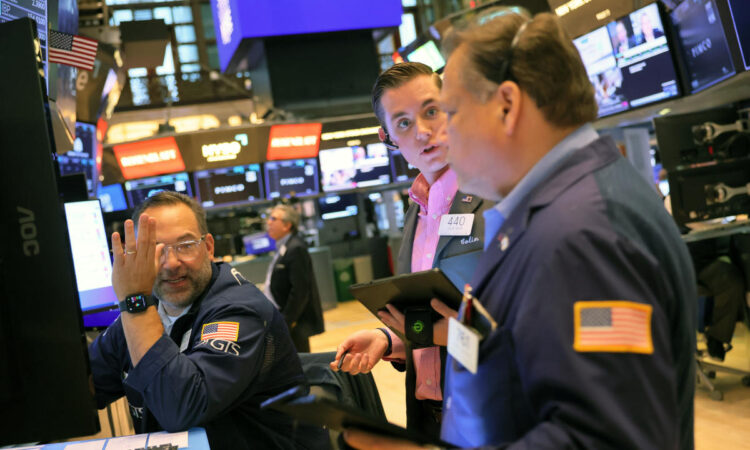
(Bloomberg) — Stocks rose ahead of major central bank decisions, key economic data and earnings from four megacaps worth nearly $10 trillion.
Most Read from Bloomberg
Almost 300 shares in the S&P 500 gained. Following a rotation that drove the Nasdaq 100 to the brink of a correction, big tech climbed — while small caps slipped. Results from Microsoft Corp., Meta Platforms Inc., Apple Inc. and Amazon.com Inc. will be crucial after an underwhelming start of the megacap reporting season. Federal Reserve officials are on the verge of lowering rates within months, a move Jerome Powell may signal Wednesday.
“The Fed and tech earnings will have the spotlight for the week,” said Paul Nolte at Murphy & Sylvest Wealth Management. “The future direction of interest rates should be clearer after the press conference. Big tech can answer whether investors’ expectations for still high growth rates is warranted.”
The S&P 500 hovered near 5,465. A gauge of the “Magnificent Seven” megacaps gained 1%. The Russell 2000 of smaller firms fell 1.1%. Tesla Inc. jumped on a bullish Morgan Stanley call. McDonald’s Corp. investors shrugged off a sales drop as executives pledged to launch new promotions. Energy producers joined a slide in oil.
Treasuries barely budged, but headed toward a third straight month of gains — the longest run since 2021. The US cut its estimate for federal borrowing for the quarter and projected its cash buffer to fall toward year-end. And companies are rushing to debt markets to raise cash before the Fed decision.
US policymakers, who’ve kept rates at a more than two-decade high for a full year, are widely expected to leave them there again on Wednesday. But investors see officials signaling a move in September as risks grow of imperiling a solid, but moderating job market. Rate decisions in Japan and the UK will also be closely watched — the former for a hike, the latter for a cut.
Bitcoin Drops as Focus Shifts to Supply From Trump Endorsement
July’s wild ride in stocks underscored how betting on seven large tech companies is no longer a simple, slam-dunk trade. During most of the month, investors jumped into other corners of the market on speculation Fed cuts will further boost Corporate America. Still, the S&P 500 ended up suffering two straight weeks of losses, dragged down by its most-influential group – technology.
“It’s almost impossible to know if the worst of the recent market pullback is over, but we continue to believe the equity market backdrop is favorable due to resilient growth, falling inflation, likely Fed rate cuts, and AI spending,” said David Lefkowitz at UBS Global Wealth Management.
Whether or not the Fed cuts rates in September, the foundations of a broad stock rally seem to be coming into place in anticipation of it, according to John Stoltzfus at Oppenheimer Asset Management.
“The dominance of a few tech names thus far this year appears not so much about California Dreamin’ or irrational exuberance — rather is reminiscent of the old adage that the technology genie once let out never goes back into its bottle — but rather morphs into new developments and trends,” he noted.
To Morgan Stanley’s Michael Wilson, a dimmer outlook for US corporate earnings is likely to hurt stocks that are tied to the economy, as investors worry about the impact of falling inflation on pricing power.
The strategist — who was among the biggest bearish voices on US stocks last year — said that a gauge that measures profit upgrades versus downgrades has turned weaker, as is typical for this time of the year. That’s being driven primarily by so-called cyclical sectors.
RBC Capital Markets strategist Lori Calvasina also said trends in earnings revisions don’t yet support a further rotation in market leadership.
So is the rotation over?
“While the selling pressure in the market’s top names won’t last forever, small caps can continue to perform well as the economy chugs along and as the Fed approaches its first rate cut of the current cycle,” said Bret Kenwell at eToro.
Going back to 1979, anytime the Russell 2000 posted a monthly gain of 10% or more, it was higher 90% of time six months later with an average gain of roughly 11.5%, he noted.
Key events this week:
-
Eurozone economic confidence, GDP, consumer confidence, Tuesday
-
US JOLTS job openings, consumer confidence, Tuesday
-
Microsoft earnings, Tuesday
-
Eurozone CPI, Wednesday
-
Bank of Japan policy decision, Wednesday
-
US ADP employment change, Wednesday
-
Fed rate decision, Wednesday
-
Meta Platforms earnings, Wednesday
-
Eurozone S&P Global Eurozone Manufacturing PMI, unemployment, Thursday
-
US initial jobless claims, ISM Manufacturing, Thursday
-
Amazon, Apple earnings, Thursday
-
Bank of England rate decision, Thursday
-
US employment, factory orders, Friday
Some of the main moves in markets:
Stocks
-
The S&P 500 was little changed as of 4 p.m. New York time
-
The Nasdaq 100 rose 0.2%
-
The Dow Jones Industrial Average fell 0.1%
-
The MSCI World Index was little changed
-
Bloomberg Magnificent 7 Total Return Index rose 1%
-
The Russell 2000 Index fell 1.1%
Currencies
-
The Bloomberg Dollar Spot Index rose 0.3%
-
The euro fell 0.3% to $1.0823
-
The British pound was little changed at $1.2865
-
The Japanese yen fell 0.1% to 153.99 per dollar
Cryptocurrencies
-
Bitcoin fell 1.1% to $67,262.3
-
Ether rose 1.5% to $3,309.56
Bonds
-
The yield on 10-year Treasuries declined two basis points to 4.17%
-
Germany’s 10-year yield declined five basis points to 2.36%
-
Britain’s 10-year yield declined five basis points to 4.05%
Commodities
-
West Texas Intermediate crude fell 1.7% to $75.83 a barrel
-
Spot gold fell 0.2% to $2,383.40 an ounce
This story was produced with the assistance of Bloomberg Automation.
–With assistance from Jeran Wittenstein, Ryan Vlastelica, Alexandra Semenova and Sagarika Jaisinghani.
Most Read from Bloomberg Businessweek
©2024 Bloomberg L.P.




